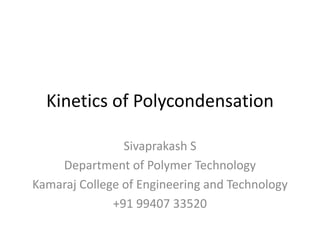
Kinetics of Polycondensation
- 1. Kinetics of Polycondensation Sivaprakash S Department of Polymer Technology Kamaraj College of Engineering and Technology +91 99407 33520
- 2. Introduction According to Flory, so long as the molecules are not quite small, the intrinisic reactivity of the functional groups present in them are independent of the molecular size. Similarly, the effect of viscosity of the reaction to the overall kinetics of a condensation reaction.
- 3. Non – catalyzed polycondensation For example, let us take the synthesis of polyester from a dicarboxylic acid and a diol. This type of esterification reaction need catalyst like acid. However no strong acid is required. The dicarboxylic acid itself acts a reactant and catalyst. The rate of the polyesterification reaction rate will be propotional to the square of the concentration of the carboxylic acid and to the first power of the hydroxyl group concentration.
- 4. Mathematical representation When the concentration of –OH and –COOH groups are equal. i.e., when we take stoichiometric quantities of the functional groups (FG), We can represent that at a given time t: [COOH]=[OH]=[FG] After rearranging and integration
- 5. Finding the concentration of FG Where [FG]0 represents the initial concentration of –COOH or –OH. If p represents the fraction of the functional group which has undergone the esterification reaction (i.e., the extent of reaction) at a time t, then [FG] could be related to [FG]0 through the following equations:
- 6. [FG] = [FG]O (1-P)
- 8. This implies that a graphical plot of 1/(1 - p)2 versus t must be linear. Experimentally, this has been found to be the case; Fig. represents a plot for the reaction between adioic acid and diethylene glycol at 166°C. For a simple esterification reaction, which proceeds without any side reaction, the number-average degree of polymerisation may be related to p, the fraction of the functional groups which has undergone the esterification at a time t, by the following equation:
- 9. Acid catalyzed polycondensation We have said earlier that the condensation reactions are enhanced by the presence of strong acids. The acid-catalysed polycondensation reaction becomes governed by the following equation:
- 10. Molecular Weight Distribution As our assumption that equimolar quantities of reactants AA and BB react and that the reactivity of groups A or B remains the same at all stages of conversion. We know that the degree of polymerization varies with the extent of polymerization that has taken place. Now, let us see how the probability factor can give an idea about the molecular weight distribution at a particular conversion p. Here, p is the extent of reaction, which also gives the probability of reaction occurring between two functional groups to give a repeat unit of -AB- asper the-reaction.
- 11. The fraction of unreacted groups is I-p. Now, assume that a tetramer is formed as a result of the reaction between 4 reactant molecules, 2 of A-A and 2 of B-B, wherein 3 pairs of reactive groups have reacted. The probability of a tetramer formation is, therefore, p2. For that matter, the probability of Occurrence of an n- mer, I.e., a polymer molecule containing n number of repeat units, will be pn-l. Assuming that at a conversion of p, the total number of polymer molecules formed is N and that of the n-mers formed is Nn, then N and N; can be related as follows:
- 12. Nn=Npn-1(1-p) If N0 is the number of reactant molecules present to start with, then N=N0 (1-p) Now, combining Eqns, Nn = N0 (1-p) Pn-1(1-p) Nn = N0 (1-p)2 Pn-1 Wn represents weight fraction
- 13. For different values of p, the Nn; and Wn distribution functions are shown in Figs., respectively. The curves in Fig. show that if we consider the number fraction, an appreciable quantity of very low molecular weight species will be present at all stages of conversion, as compared to high molecular weight spices. On the other hand, if we consider the weight fraction. The very low molecular weight species will be present in a negligible quantity, as compared to high molecular weight species.
- 16. On the other hand, if we consider the weight fraction. The very low molecular weight species will be present in a negligible quantity, as compared to high molecular weight species. Equation which relates the weight-fraction distribution with the extent of reaction can also be used in determining the extent of reaction that should be attained if we want to get a maximum yield of a particular molecular weight species. Thus. from Eqn. we can derive:
- 17. Extent of Reaction and Degree of polymerization We know that Let us put different values of P and get the corresponding values of , which are listed in the table. It may be noted that in order to get a relatively high degree of polymerization pr a high molecular weight polymer, the extent of conversion has to be very high. We can see from table that even for a degree of polymerization of 100 (which, in fact, corresponds to low molecular weight polymers), conversion has to be as high as 99%.
- 18. Values of p Extent of conversion (%) Degree of polymerization 0.50 50 2 0.90 90 10 0.95 95 20 0.99 99 100 0.999 99.9 1000 0.99999 99.999 100000 Effect of extent of conversion on degree of polymerization for polycondensation reaction
